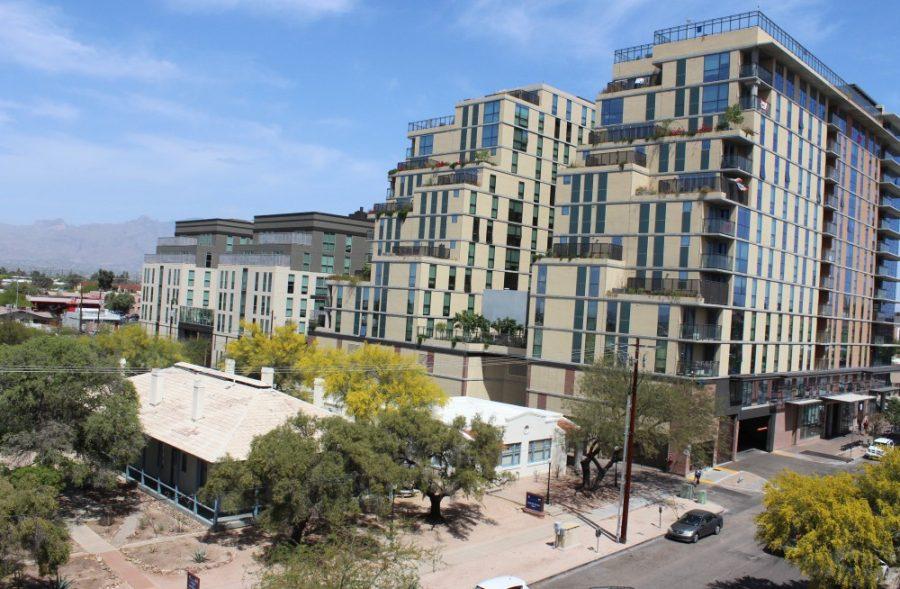The idea of a party dorm like Coronado Residence Hall in a quiet Tucson neighborhood has elicited passionate objections from communities bordering the University of Arizona campus.
Within the past year, several major student housing projects have either broken ground or been proposed within a few miles of the UA campus, including The Hub on Campus Tucson Speedway, The Union on Sixth, The Mark at Tucson and Aspire Tucson, as well as the UA’s Honors Complex.
In hall meetings, neighborhood forums and online real estate blogs, community members are wondering how the student housing market could be so big, and why some proposals are so huge.
“Why does it have to be so tall?” asked a Miramonte resident in regards to a proposed multi-building, seven-story apartment complex on Country Club Road during a special meeting on March 28 at the former Tucson Benedictine Monastery. “Why can’t it be two stories shorter all the way around?”
Developers take different approaches
Why are so many developers getting into the student housing scene? Well, it’s profitable.
Most student housing requires tenants pay for a bedroom in a one-to-four-bedroom apartment and share a common room, kitchen and bathroom. Monthly rates can range from $500 to over $1,000.
During that same March 28 public meeting at the former monastery, local developer Ross Rulney explained his reasoning before a tough crowd of Miramonte neighborhood stakeholders regarding the development of the historical monastery into luxury homes or student housing.
“I want to be clear and upfront: I don’t want you coming away from this meeting thinking that there’s a chance I’m considering anything else. If you want me to be the developer, I need to build up to seven stories to make this economically viable,” Rulney said.
In return, Rulney would not go through with the plan he formed before taking into account the community response: selling the property to a student housing developer for much more than he paid — $5.9 million. At that point the fate of the monastery would be out of the community’s hands.
Additionally, as part of his newer plan, he would register the monastery as a historic structure so that it could not ever be torn down.
Another local developer, Michael Goodman, has taken another route. Goodman is suing the City of Tucson under the Private Property Rights Protection Act, which states that if a Arizona government took any action that decreases the value of a landowner’s property, the owner can sue. Goodman claims that zoning codes devalued his property and is asking for $12.5 million, according to an article by the Tucson Improvement and Beautification Organization.
However, Goodman has negotiated to drop the lawsuit if the city allows him to develop to the full extent of his plan.
Rulney is pushing to have his property be developed to the full extent of his plan, but he is at the same time committing extra time and effort to provide the neighborhood a product they would approve of instead of selling the property for a fast and easy return.
But to do so profitably, he said he has to build to allow for a determined density, and that means extra height.
UA’s Honors College Complex also under scrutiny
Some community residents and at least one city council member are calling for the university to build upwards, since there is very little area left belonging to the UA that is feasible for more student housing.
In a December 2017 Tucson Weekly article, Ward 6 City Councilman Steve Kozachik referred to two projects, the Hub at Tucson 2 and UA’s new honors college complex, as “degrading the quality of life” for neighborhood residents.
RELATED: Former Honors College dean sues Board of Regents in federal court
Then, in a February 2018 interview with Inside Tucson Business, Kozachik said UA needs to build vertically in its own footprint, referring to a proposed seven-story apartment on Fourth Avenue.
Construction of the new honors complex is causing tension between the neighborhood and the university because, as a state institution, the university can build outside its planning area regardless of Tucson zoning ordinance rules.
In an area of predominantly one-to-two-story structures, the honors complex will be six stories at its highest and house over 1,000 students. For context, all of the campus dormitories together currently house about 7,000 students.
In enrollment graphs released by the UA, total university headcount has been rising steadily since 1996, from 33,504 to 43,625 total students since 2016. This means tens of thousands of UA students have to live off campus.
Furthermore, dozens of the student housing properties within five miles of the UA claim to be within 80–99 percent occupancy, which proves a high demand for off-campus housing.
For the community around campus, this means that more students are coming to Tucson and more housing must be built to accommodate them. While the neighborhoods cannot stop the influx of students, they can rally to protect the zoning laws put into place by
city planners.
The question now is not whether Tucson needs more student housing, but whether Tucson can protect its culture and character through zoning.
Follow Ian Green on Twitter









